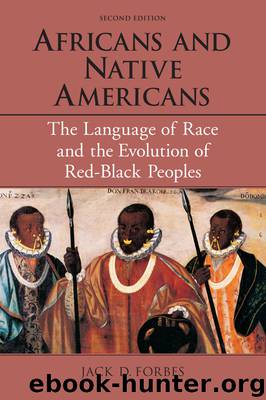Africans and Native Americans by Jack D. Forbes

Author:Jack D. Forbes
Language: eng
Format: epub
Publisher: University of Illinois Press
Published: 2018-04-14T16:00:00+00:00
EXPLICIT DEFINITIONS IN SPANISH
Now let us turn to an examination of Spanish definitions, briefly incorporating therein some of the specific statements referred to earlier under usage.
The earliest Spanish dictionaries, those of Nebrija (1495, 1513, et cetera) contain no mention of mulato as applied to human beings. This is also the case with Las Casas’ Tuscan–Castillian dictionary (1570, 1600). The first documentation occurs instead in reports or legislation relating to the Americas as already discussed. To review that material let us construct a short list:
1568 Royal order defines a mulato as a child of negro and india.
1574 Viceroy Enríquez of Mexico states that mulatos are not sons of Spaniards.
1574 López de Velasco states that mulatos are children of negros and indias and, much less commonly, of Spaniards and negras.
1583 Cabello Balboa uses mulato for American–Africans in Ecuador.
1592 Royal order states that mulatos (Venezuela) are hijos de indias.
1599 Mixed African–American chieftains from Esmeraldas called mulatos.
From the character of these definitions we stated earlier that mulato seems to have meant half-Black African and, ordinarily, half-American but with the half-African part being apparently essential. To this must be added, ‘or one who looks half-African’.
Interestingly, John Minsheu’s English–Spanish dictionary (1599, 1626) states for mulato, mulata: ‘the son (or daughter) of a blackmoore and one of another nation’. In his 1617 vocabularium Minsheu states:
[Latin] Filus maurae & hominis albi coloris vel è contra.
[English] the Sonne of a woman black-moore and a man of another nation, or of a black-more and the woman of another nation.
In his 1617 Guide Minsheu has:
mulato, hoc nomine Hispan: vocant genitum ex mauro/patre, & alterius nationis matre, vel è converso.
Thus Minsheu, obviously an excellent student of contemporary Spanish, understood that mulato meant halt-mauro (Latin) or half-Blackmoor (English).49
Minsheu’s influence was understandably great and many English dictionaries continued his tradition. In 1656, for example, Blount repeated the same definition (half-Blackmore, half-another nation) and added: ‘one that is of a mongrel complexion’. Minsheu was followed, in essence, through Kersey’s 1708 Dictionarium. Most attributed the word directly to Spanish.50
In 1602 Garcilaso de la Vega, the half-Inca scholar, after traveling widely (in Europe as well as America) and after interviewing old Spanish soldiers wrote: ‘In all of the West Indies, those of us who are born of a Spanish father and an Indian mother are called mestizos, just as in Spain those who are born of a Negro father and an Indian mother or vice versa are called mulatos.’51
In 1613, after many decades of research and travel in Peru, Huaman Poma (a Quechua Indian) wrote: ‘when mulattoes – a mixture of negro and Indian – produce quadroon children, these children lose all physical trace of their negro origin except for the ear, which still gives them away by its shape and size.’
In 1617 Garcilaso de la Vega’s history of Peru was finished. In it he states: ‘mulato, hijo de negro e india’, that is, that a mulatto is the child of a male Negro and a female American. He also adds that the word cholo was then
Download
This site does not store any files on its server. We only index and link to content provided by other sites. Please contact the content providers to delete copyright contents if any and email us, we'll remove relevant links or contents immediately.
| African-American Studies | Asian American Studies |
| Disabled | Ethnic Studies |
| Hispanic American Studies | LGBT |
| Minority Studies | Native American Studies |
Cecilia; Or, Memoirs of an Heiress — Volume 1 by Fanny Burney(32489)
Cecilia; Or, Memoirs of an Heiress — Volume 2 by Fanny Burney(31909)
Cecilia; Or, Memoirs of an Heiress — Volume 3 by Fanny Burney(31887)
The Great Music City by Andrea Baker(31752)
We're Going to Need More Wine by Gabrielle Union(18997)
All the Missing Girls by Megan Miranda(15760)
Pimp by Iceberg Slim(14433)
Bombshells: Glamour Girls of a Lifetime by Sullivan Steve(14019)
For the Love of Europe by Rick Steves(13493)
Talking to Strangers by Malcolm Gladwell(13284)
Norse Mythology by Gaiman Neil(13268)
Fifty Shades Freed by E L James(13184)
Mindhunter: Inside the FBI's Elite Serial Crime Unit by John E. Douglas & Mark Olshaker(9258)
Crazy Rich Asians by Kevin Kwan(9214)
The Lost Art of Listening by Michael P. Nichols(7451)
Enlightenment Now: The Case for Reason, Science, Humanism, and Progress by Steven Pinker(7270)
The Four Agreements by Don Miguel Ruiz(6693)
Bad Blood by John Carreyrou(6580)
Weapons of Math Destruction by Cathy O'Neil(6204)
